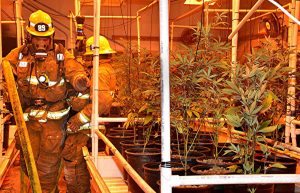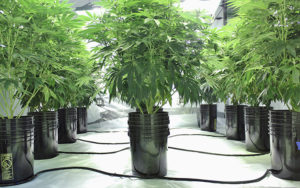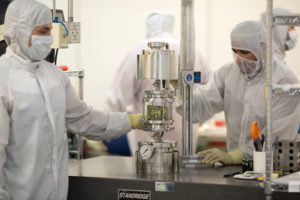 The cannabis industry has gone through a rapid expansion and with the expansion comes an increase in cultivation as well as extraction facilities. But, as with any industrial process, production comes with an assortment of hazards.
The cannabis industry has gone through a rapid expansion and with the expansion comes an increase in cultivation as well as extraction facilities. But, as with any industrial process, production comes with an assortment of hazards.
The NFPA Standards Council has approved the development of NFPA 420 (Fire Protection of Cannabis Growing and Processing Facilities Standard). This new standard, which was originally proposed in response to serious fires that have occurred at cannabis facilities in recent years, will provide clear guidance on fire protection standards for facilities that produce, process, and extract cannabis.
The number of states passing laws to permit the use of cannabis for medicinal and recreational purposes continues to increase, and this has many jurisdictions trying to navigate uncharted territory. The first step in understanding what safety risks are present in a cannabis-related facility is knowing what type of facility is being proposed or inspected.
Often, cannabis-related facilities will focus on one aspect of the industry: growing, processing, or selling. Each of these types of facilities presents unique hazards and related safety issues.
Cannabis Industry Facilities
 Not all fire hazards present in cannabis facilities are unique to the industry, so it is important to remember that the fire code, building code, and other applicable regulations might already have provisions for dealing with some of the hazards present.
Not all fire hazards present in cannabis facilities are unique to the industry, so it is important to remember that the fire code, building code, and other applicable regulations might already have provisions for dealing with some of the hazards present.
However, there are hazards unique to growing and processing facilities, these hazards are addressed by NFPA Fire Code. This contains requirements for fire inspectors to help ensure the safety of building occupants, the safety of firefighters, and the protection of property where cannabis is grown or processed.
Occupancy Classification
 The hazards in an occupancy vary based on the types of activities being conducted, the types of materials being used, and the quantities of the materials being used. The most fundamental question when it comes to cannabis facilities is:
The hazards in an occupancy vary based on the types of activities being conducted, the types of materials being used, and the quantities of the materials being used. The most fundamental question when it comes to cannabis facilities is:
- What is the occupancy classification?
The occupancy classification of the facility should be based on the occupancy definitions found in NFPA and the applicable building code. Depending on the facility and its use, some likely occupancy classifications for cannabis-related facilities may be:
- Growing & Processing Facilities (including extraction rooms): Classified as industrial or storage.
- Selling Facilities: Classified as mercantile.
- Consumption Facilities: May be classified as assembly or business depending on the occupant load.
Just like other types of buildings, there could be more than one occupancy present. If that is the case, the building would need to be protected as a multiple occupancy building as outlined by NFPA. Similar to other types of facilities, the hazard of contents would also need to be evaluated.
If the facility was found to have high-hazard contents, which are contents that are likely to burn with extreme rapidity or are likely to explode, then the provisions of the high-hazard content would need to be applied.
Cannabis Cultivation Facilities
 Growing facilities are typically large warehouse-type buildings subdivided into rooms. The grow rooms are closely monitored to provide exactly the right conditions for the cannabis plants.
Growing facilities are typically large warehouse-type buildings subdivided into rooms. The grow rooms are closely monitored to provide exactly the right conditions for the cannabis plants.
Usually, plants are moved throughout the building as they reach different stages and require different conditions for optimal growth. While there are several things to consider when inspecting these types of facilities, two (2) important questions to ask are the following:
- What types of containers and trays are the plants growing in?
- What types of fertilizers and fumigants are being stored and used?
The growing cannabis plants are typically not very combustible. They are kept under such moist conditions that flaming combustion would likely be difficult to achieve. However, the other materials present can and will impact fire growth. The types of containers and trays that the plants are growing in, as well as the growing medium, could impact things like the sprinkler system design.
Fertilizers and fumigants could be hazardous materials, oxidizers, or hazardous to humans. Any of those types of materials could require additional requirements to be followed, such as those for high-hazard contents (that’s why the cannabis industry fire safety is essential).
Cannabis Processing Facilities
 Processing facilities are all the other types of facilities that transform the plant into products for consumption, but one common type of processing facility is an extraction room. During the extraction process, chemicals are removed from the plant for use in other cannabis-based products.
Processing facilities are all the other types of facilities that transform the plant into products for consumption, but one common type of processing facility is an extraction room. During the extraction process, chemicals are removed from the plant for use in other cannabis-based products.
The extraction process is commonly completed by using a solvent, such as Liquefied Petroleum (LP) gas or Carbon Dioxide (CO2), to strip the oils holding these chemicals from plant clippings. While there are several things to consider when inspecting these types of facilities, the following are two (2) important questions to ask:
- What hazardous materials are used in the facility?
- How much hazardous material do they have within control areas?
Hazardous materials are used throughout the production of cannabis, mainly during the extraction process. Other chapters in NFPA provide requirements for hazardous materials, including limitations on the Maximum Allowable Quantities (MAQs), protection of areas that use excessive quantities of hazardous materials, separation of areas using hazardous materials, and safe practices for those materials in use.
It is important to identify the types and quantities of the hazardous materials present to properly apply NFPA.
Existing Cannabis Industry Facilities
 For existing facilities, it is important to keep in mind that this is an ever-changing industry. Although these types of facilities might be on a set inspection schedule, additional inspections could be required.
For existing facilities, it is important to keep in mind that this is an ever-changing industry. Although these types of facilities might be on a set inspection schedule, additional inspections could be required.
Some examples of times when additional inspections could be needed are when any of the following changes occur at a facility:
- Modifications to the grow area, rooms and storage areas, extraction equipment, process rooms, or processing equipment within a facility.
- Changes in occupancy.
- Changes in the material used in a new or existing grower or processor facility.
There are inherent dangers in cannabis-related facilities and the more that is understood about how these facilities operate, the safer the facility, its workers, and responders will be. Outlined above are the very basics, but there is always more to consider especially for an industry that is changing so rapidly.
Other considerations include proper permitting, proper sprinkler system design, and how to inspect and regulate new extraction processes. Regardless of what role you have in this (building owner, inspector, first responder, etc.), there is a common goal:
- To maintain the highest level of safety in these types of facilities
Ensuring that facilities comply with the appropriate standards is one way of doing that. With the cannabis industry poised for rapid expansion, we will find a host of lessons learned, including safety practices at commercial grow and extraction facilities, inspection protocols, and more.
Let us know what you think.




Responses